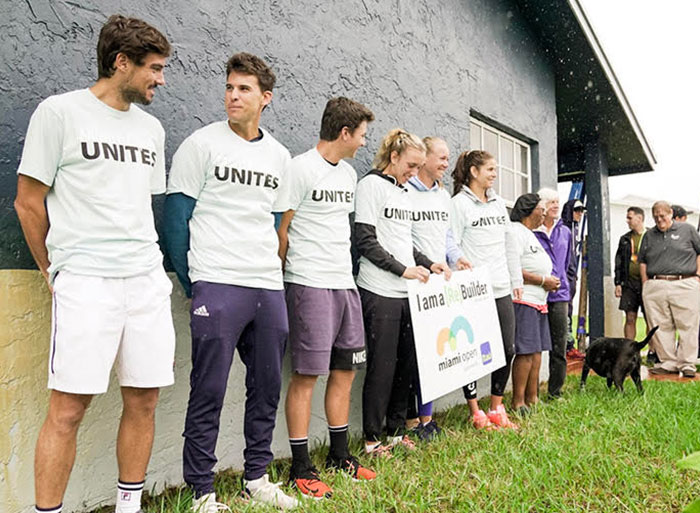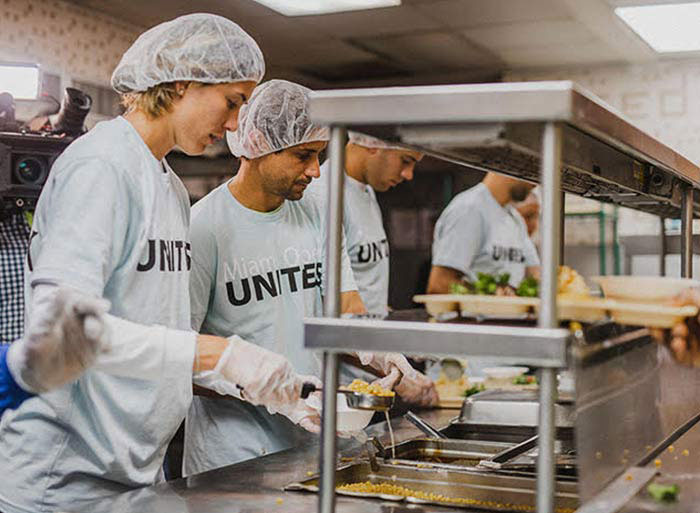Miami Open Unites
Miami Open Unites Connects Players and Communities Who Share Similar Journeys
By Tucker Verdi
In a suite overlooking Stadium Court of the Miami Open presented by Itaú, a panel of seven of the biggest names in tennis sat before an awestruck crowd of high school tennis players and young children empowered to be active in their communities as part of the UNICEF Kid Power Program.
There were kids from disadvantaged neighborhoods in South Florida, kids who came to this country not speaking a word of English, and kids who survived one of the deadliest mass shootings in U.S. history.
They were all gathered to discuss the different kinds of adversity they have all faced, and engage with the players about their own experiences in facing and overcoming challenges both on and off the court. The students were asked what inspires them each day; what drives them to be a positive force in their communities.
When a young girl raised her hand to ask a question to these stars of the game, any number of things could have been on her mind. She could have asked what their favorite thing about playing tennis is. Or how cool it is to fly around the world for a living. Or even what it’s like to get nice clothes for free.
But she didn’t ask about tennis or fame or fortune. What she did ask reinforces why events that connect players with the communities around them continue to be as important as ever.
“Is there anybody that inspires you?”
—
On Tuesday, during what became a rain-soaked late morning in the Miami area, the Miami Open in conjunction with the ATP and WTA tours put on a series of outreach events with local service groups, organized under the moniker of Miami Open Unites.
Community Impact

Rebuilding Together
At a home in Miami Gardens, FL, Miami Open Unites partnered with Rebuilding Together, an organization that offers assistance in repairing and rebuilding homes to senior citizens, veterans, and the disabled. Dominic Thiem, Guido Pella, Kiki Bertens, Julie Görges, Miomir Kecmanovic, and Elise Mertens, joined forces with Miami Open Unites volunteers to help paint and landscape the home.

Feeding the Homeless
At Miami Rescue Mission, an organization that houses, feeds, and provides resources for the homeless in the South Florida region, Miami Open Unites took on the task of giving to those in need. Garbiñe Muguruza, Grigor Dimitrov, David Ferrer, Borna Coric, and Anett Kontaveit, assisted in serving lunch to those living in the shelter.

Humane Society of Greater Miami
At the Sofer and Fine Adoption Center in North Miami Beach, players and volunteers partnered with the Humane Society of Greater Miami. Sascha Zverev, John Isner, Jelena Ostapenko, Danielle Collins, Robert Bautista Agut, Ashleigh Barty, and Belinda Bencic, were on hand to help grooming, as doing so increases their chances of finding a permanent home. Zverev even decided to add a new member to his family, taking home one of the pups for himself.

Baptist Children’s Hospital
At the Baptist Children’s Hospital — South Florida’s premier children’s medical center, players spent time with children and gifted them toys provided by the WTA Foundation. Bob and Mike Bryan and Aryna Sabalenka made their way around the hospital in hopes of providing a boost for kids in need of care and positivity.

UNICEF Kid Power
Petra Kvitova, Stefanos Tsitsipas, and Kei Kishikori hangout with children from the UNICEF Kid Power Program.
And in that same suite overlooking Stadium Court at the Miami Open, students from UNICEF’s Kid Power Program joined with players from the Stoneman Douglas High School tennis team and top names Petra Kvitova, Marin Cilic, Kei Nishikori, Stefanos Tsitsipas, Nicolas Jarry, Diego Schwartzman, and Nick Kyrgios, to have a Q&A. Together, they discussed overcoming adversity in life, finding power in oneself, and having a presence in one’s community.
—
It was one of these UNICEF Kid Power children who asked that affecting question. In a room full of children who, at such a young age, have taken an incredibly important and mindful step to be involved and impactful in their communities, some of the top tennis minds paused and looked at each other.
On an average day, they are the ones providing the inspiration. To fans from around the world, they are the heroes; the “Supermen” and “Wonder Women” — as explained by Stoneman Douglas girls tennis coach Amy Pena.
Cilic was quick to explain, however, that in that moment inspiration flowed the other way.
“For me personally, I believe that even kids like you can be an inspiration for us,” the US Open champion in 2014 said. “Anyone who is reaching their full potential, who is trying everyday to be the best version of their self, and who is constantly trying to improve in every possible way is an inspiration.”
Not only are these kids providing inspiration, but they are providing meaningful change in communities that need it the most. At an age when service and selflessness are rarely seen or expected, these young heroes have stepped up. They are working daily to be the best they can be, and allow that best version of themselves to have an impact on the world around them.
—
The cycle of inspiration is one that is essential to lifting people out of their darkest moments. Each generation can pave a new path for the one that follows by inspiring in them a strength to overcome the biggest obstacles.
Kei Nishikori spoke of moving to a new country at a young age without knowing the language or the people. Several students had spoken about a similar journey.
Stefanos Tsitsipas and Diego Schwartzman shared their stories of trying to pursue their dreams in times of economic hardship. Several students nodded in solidarity, as they continue to face similar obstacles.
Petra Kvitova spoke to the girls about pursuing their dreams despite what people might say is expected of them.
Each had a story that resonated with someone in the audience. A story that they could connect with, through mutual hardship and struggle. These common struggles provide an avenue — a gateway, for inspiration to take root and affect deep and lasting change.
Whether it’s painting the line with an exceptional forehand on championship point or painting the home of an elderly woman in need. Whether its providing an exhilarating display of tennis on the world stage or providing a permanent home for an abused or neglected dog. Or whether its connecting with millions of fans around the world or just one who now knows he or she isn’t alone in his or her struggle to fit into a new world.
The players and volunteers participating in this day of service devoted to giving back have connected with communities in hopes of providing assistance and inspiration to the most vulnerable among the South Florida region. And, in the process, they have shared their similar dreams, struggles, and ways of persevering.
The Miami Open presented by Itaú annually provides a stage for some of the best tennis in the world, and the incredible players who make it happen. It also displays a showcase of that which is most beautiful about South Florida — its cultural diversity in its communities.
The Miami Open entertains, the Miami Open inspires, and — maybe most importantly, with the beginning of this annual initiative bringing together players and communities to give back, the Miami Open Unites.





